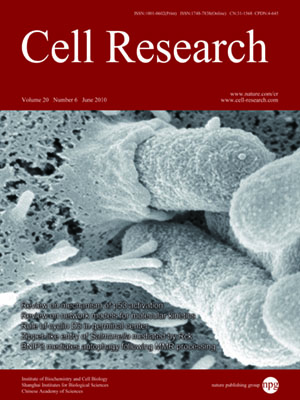
Volume 20, No 6, Jun 2010
ISSN: 1001-0602
EISSN: 1748-7838 2018
impact factor 17.848*
(Clarivate Analytics, 2019)
Volume 20 Issue 6, June 2010: 688-700
ORIGINAL ARTICLES
Disruption of the 1-deoxy-D-xylulose-5-phosphate reductoisomerase (DXR) gene results in albino, dwarf and defects in trichome initiation and stomata closure in Arabidopsis
Shufan Xing1, Jin Miao1, Shuang Li1, Genji Qin1, Si Tang1, Haoni Li1, Hongya Gu1,2 and Li-Jia Qu1,2
1National Laboratory for Protein Engineering and Plant Genetic Engineering, College of Life Sciences, Peking University, Beijing 100871, China
2The National Plant Gene Research Center (Beijing), Beijing 100101, China
Correspondence: Li-Jia Qu,(qulj@pku.edu.cn)
1-Deoxy-D-xylulose-5-phosphate reductoisomerase (DXR) is an important enzyme involved in the 2-C-methyl-D-erythritol-4-phosphate (MEP) pathway which provides the basic five-carbon units for isoprenoid biosynthesis. To investigate the role of the MEP pathway in plant development and metabolism, we carried out detailed analyses on a
dxr mutant (GK_215C01) and two
DXR transgenic co-suppression lines, OX-DXR-L2 and OX-DXR-L7. We found that the
dxr mutant was albino and dwarf. It never bolted, had significantly reduced number of trichomes and most of the stomata could not close normally in the leaves. The two co-suppression lines produced more yellow inflorescences and albino sepals with no trichomes. The transcription levels of genes involved in trichome initiation were found to be strongly affected, including
GLABRA1,
TRANSPARENT TESTA GLABROUS 1,
TRIPTYCHON and
SPINDLY, expression of which is regulated by gibberellic acids (GAs). Exogenous application of GA
3 could partially rescue the dwarf phenotype and the trichome initiation of
dxr, whereas exogenous application of abscisic acid (ABA) could rescue the stomata closure defect, suggesting that lower levels of both GA and ABA contribute to the phenotype in the
dxr mutants. We further found that genes involved in the biosynthetic pathways of GA and ABA were coordinately regulated. These results indicate that disruption of the plastidial MEP pathway leads to biosynthetic deficiency of photosynthetic pigments, GAs and ABA, and thus the developmental abnormalities, and that the flux from the cytoplasmic mevalonate pathway is not sufficient to rescue the deficiency caused by the blockage of the plastidial MEP pathway. These results reveal a critical role for the MEP biosynthetic pathway in controlling the biosynthesis of isoprenoids.
Cell Research (2010) 20:688-700. doi:10.1038/cr.2010.54; published online 20 April 2010
FULL TEXT | PDF
Browse 2231


